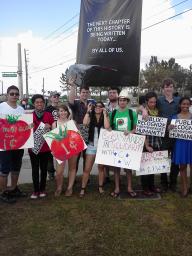| |
|
|
| |

|
Grade:
Grade 5
Subject: English Language Arts
Created by:
Jessica Jensen
Lesson Length:
45 minutes
Keywords/Tags:
culture learning immigration language
Lesson Description:
The passage refers to a student that has lived in to different cultures. The students should reflect throughout the reading and be able to compare and contrast their experiences with the example in the reading. They should also identify new words and learn the meanings. |
Common Core Standards Covered with This Lesson
- CCSS.ELA-Literacy.RL.5.10: By the end of the year, read and comprehend literature, including stories, dramas, and poetry, at the high end of the grades 4–5 text complexity band independently and proficiently.
- CCSS.ELA-Literacy.RI.5.1: Quote accurately from a text when explaining what the text says explicitly and when drawing inferences from the text.
- CCSS.ELA-Literacy.RF.5.3: Know and apply grade-level phonics and word analysis skills in decoding words.
- CCSS.ELA-Literacy.RF.5.4a: Read grade-level text with purpose and understanding.
- CCSS.ELA-Literacy.W.5.2: Write informative/explanatory texts to examine a topic and convey ideas and information clearly.
- CCSS.ELA-Literacy.W.5.2a: Introduce a topic clearly, provide a general observation and focus, and group related information logically; include formatting (e.g., headings), illustrations, and multimedia when useful to aiding comprehension.
- CCSS.ELA-Literacy.W.5.4: Produce clear and coherent writing in which the development and organization are appropriate to task, purpose, and audience. (Grade-specific expectations for writing types are defined in standards 1–3 above.)
- CCSS.ELA-Literacy.W.5.8: Recall relevant information from experiences or gather relevant information from print and digital sources; summarize or paraphrase information in notes and finished work, and provide a list of sources.
- CCSS.ELA-Literacy.W.5.9a: Apply grade 5 Reading standards to literature (e.g., “Compare and contrast two or more characters, settings, or events in a story or a drama, drawing on specific details in the text [e.g., how characters interact]â€).
- CCSS.ELA-Literacy.L.5.2e: Spell grade-appropriate words correctly, consulting references as needed.
- CCSS.ELA-Literacy.L.5.4a: Use context (e.g., cause/effect relationships and comparisons in text) as a clue to the meaning of a word or phrase.
- CCSS.ELA-Literacy.L.5.5c: Use the relationship between particular words (e.g., synonyms, antonyms, homographs) to better understand each of the words.
|
|
|
| |
|
|
| |
|
|
| |
|
Lesson Content: Reading
|
|
| Instructions: Please read the following reading passage as many times as needed (aloud and silent) before starting to go through other lesson pages. Understanding the content of this passage is very important since the lesson activities will be all about this content. Feel free to print the passage if needed. |
Wh o Am I? I am two cultures.
I am proud to be a member of two cultures. Even though I am only ten years old, I have lived in two countries and in two cultures. I have lived in both Mexico and the United States.
I was born in the state of Michoacán. I was born in a small town called Quinceo. Life there was simple and peaceful. There was a small church where we would go to hear mass on Sundays. There was a corral where we would go and watch rodeos. After school, my friends and I would go for a swim in a creek. My mom did not work; she stayed at home taking care of our family. Life in Quinceo was nice, but money was sometimes not enough to support us.
In 1996, the day came when my dad decided to bring us to the United States. Leaving my town was hard, but it was important that my family stay together. When I left Mexico, I had a lot of special friends and nice teachers.
When I first came to the United States, I started at a new school in Chicago. I found care and company at the school, among Hispanic people, my friends, and my teacher. She helped me all the time.
My education now is different from the one in Mexico. Here, I am studying in two languages. I feel very happy because I am able to communicate in two languages. In my case, speaking Spanish is an indication of my Mexican heritage. Speaking English is a symbol of my triumph and the struggles that I have as an immigrant in this country. Now that I have been here three years, I am proud to offer my help and support to people who need it.
I urge those who come from Mexico and other countries to learn English and to continue speaking their native language, too. It will help them reach out to others.
|
|
|
| |
|
|
| |
|
|
| |
|
Task 1: Vocabulary Activity (40 points)
|
|
| Instructions: Please complete the following vocabulary activity by choosing the correct meaning of each word selected from the passage and use of each word correctly in a sentence. |
|
|
|
| Standards Covered with This Lesson Activity: CCSS.ELA-Literacy.RL.5.10, CCSS.ELA-Literacy.RF.5.3, CCSS.ELA-Literacy.RF.5.4a, CCSS.ELA-Literacy.W.5.2, CCSS.ELA-Literacy.L.5.2e, CCSS.ELA-Literacy.L.5.5c, |
|
|
| |
|
|
| |
|
|
| |
|
Task 2: Discussion Activity (30 points)
|
|
| Instructions: This discussion forum will have questions for students to respond. Read the posted questions, and respond to each. Students are responsible for posting one initial and and two peer responses for each topic. |
|
|
| Standards Covered with This Lesson Activity: CCSS.ELA-Literacy.W.5.2a, CCSS.ELA-Literacy.W.5.9a, CCSS.ELA-Literacy.L.5.4a, |
|
|
| |
|
|
| |
|
|
| |
|
Task 3: Writing Activity (30 points)
|
|
| Instructions: Please share an example of when you have experienced multipule cultures. It can be when you visited another place, if you've lived in another country or if you have been rasied in a culturally different setting.
|
|
|
Standards Covered with This Lesson Activity:
CCSS.ELA-Literacy.RI.5.1, CCSS.ELA-Literacy.W.5.4, CCSS.ELA-Literacy.W.5.8, |
|
|
| |
|
|
University of South Florida Patent & Copyright Office © 2017 (Tech ID # Pending)
|
